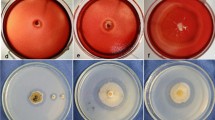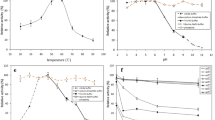Abstract
Fungi producing xylanases are plentiful but alkali-thermo-tolerant fungi producing cellulase-poor xylanase are rare. Out of 12 fungal strains isolated from various sources, Coprinellus disseminatus SW-1 NTCC 1165 yielded the highest xylanase activity (362.1 IU/ml) with minimal cellulase contamination (0.64 IU/ml). The solid state fermentation was more effective yielding 88.59% higher xylanase activity than that of submerged fermentation. An incubation period of 7 days at 37°C and pH 6.4 accelerated the xylanase production up to the maximum level. Among various inexpensive agro-residues used as carbon source, wheat bran induced the maximum xylanase titres (469.45 IU/ml) while soya bean meal was the best nitrogen source (478.5 IU/ml). A solid substrate to moisture content ratio of 1:3 was suitable for xylanase production while xylanase titre was repressed with the addition of glucose and lactose. The xylanase and laccase activities under optimized conditions were 499.60 and 25.5 IU/ml, respectively along with negligible cellulase contamination (0.86 IU/ml). Biochemical characterization revealed that optimal xylanase activity was observed at pH 6.4 and temperature 55°C and xylanase is active up to pH 9 (40.33 IU/ml) and temperature 85°C (48.81 IU/ml). SDS–PAGE and zymogram analysis indicated that molecular weight of alkali-thermo-tolerant xylanase produced by C. disseminatus SW-1 NTCC 1165 was 43 kDa.










Similar content being viewed by others
References
Abdel-Raheem AM, Badran R (1998) Xylanolytic activity of some river Nile aquatic hyphomycetes species. Egypt J Microbiol 33:109–124
Aiba S, Humphrey AE, Millis NF (1973) Kinetics. In: Biochemical engineering, 2nd edn. Academic Press, New York, pp 92–127
Anthony T, Chandra Raj K, Rajendran A, Gunasekaran P (2003) High molecular weight cellulase-free xylanase from alkali-tolerant Aspergillus fumigatus AR1. Enzyme Microbiol Technol 32:647–654
Archana A, Satyanarayana T (1997) Xylanase production by thermophilic Bacillus licheniformis A99 in solid-state fermentation. Enzyme Microbiol Technol 21(1):12–17
Asha Poorna C, Prema P (2007) Production of cellulase-free endoxylanase from novel alkalophilic thermotolerant Bacillus pumilus by solid-state fermentation and its application in wastepaper recycling. Bioresour Technol 98:485–490
Ashok Prabhu K, Maheshwari R (1999) Biochemical properties of xylanases from a thermophilic fungus, Melanocarpus albomyces and their action on plant cell walls. J Biosci 24(4):461–470
Babu KR, Satyanarayana T (1996) Production of bacterial enzymes by solid-state fermentation. JSIR 55:464–467
Beg QK, Bhushan B, Kapoor M, Hoondal GS (2000) Enhanced production of a thermostable xylanase from Streptomyces sp. QG-11–3 and its application in biobleaching of eucalyptus kraft pulp. Enzyme Microbiol Technol 27:459–466
Bennett NA, Ryan J, Biely P, Vrsanska M, Kremnicky L, Macris BJ, Kekos D, Christakopoulos P, Katapodis P, Claeyssens M, Nerinckx W, Ntauma P, Bhat MK (1998) Biochemical and catalytic properties of an endoxylanase purified from the culture filtrate of Thermomyces lanuginosus ATCC 46882. Carbohydr Res 306:445–455
Carmona EC, Aline A, Pizzironi-Kleiner Aline A, Monteiro Rosim Regina T, Jorge JA (1997) Xylanase production by Aspergillus versicolor. J Basic Microbiol 37(6):387–394
Chandra Raj K, Chandra TS (1995) Production of cellulase-free xylanase from an alkalo-tolerant Aspergillus fischeri Fxn1. Biotechnol Lett 17:309–314
Collins T, Gerday C, Feller G (2005) Xylanases, xylanase families and extremophilic xylanases. FEMS Microbiol Rev 29:3–23
de Souza-Cruz PB, Freer J, Siika-Aho M, Ferraz A (2004) Extraction and determination of enzymes produced by Ceriporiopsis subvermispora during biopulping of Pinus taeda wood chips. Enzyme Microbiol Technol 34(3–4):228–234
Decelle B, Tsang A, Storms RK (2004) Cloning, functional expression and characterization of three Phanerochaete chrysosporium endo-1, 4-β-xylanases. Curr Genet 46:166–175
Elegir G, Szakacs M, Jeffries TW (1994) Purification, characterization and substrate specificities of multiple xylanases from Streptomyces sp. strain B-12–2. Appl Environ Microbiol 60:2609–2615
Feniksova RV, Tikhomrova AS, Rakhleeva BE (1960) Conditions for forming amylase and proteinase in surface culture of Bacillus subtilis. Mikrobiologica 29:745–748
Gabriel BL (1982) Biological scanning electron microscopy. Von Nostrand Reinhold Company, New York, p 186
Gervais P, Abadie C, Molin P (1999) Fungal turger pressure is directly involved in the hyphal growth rate. Microbiol Res 154:81–87
Haltrich D, Nidetzky B, Kulke KD, Stenier W, Zupancic S (1996) Production of fungal xylanase. Bioresour Technol 58:137–161
Hölker U, Höfer M, Lenz J (2004) Biotechnological advantages of laboratory-scale solid-state fermentation with fungi. Appl Microbiol Biotechnol 64(2):175–186
Jain A (1995) Production of xylanase by thermophilic Melanocarpus albomyces IIS-68. Process Biochem 30:705–709
Kapoor N (2005) Studies on the microbial production of xylanase by Aspergillus niger. Ph.D. thesis. Indian Institute of Roorkee, Roorkee, p 97
Khan A, Haq I, Qadeer MA, Ali S, Butt WA (2002) Effect of carbon and nitrogen sources on xylanase production by mutant strain of Aspergillus niger GCBMX-45. Online J Biol Sci 2(2):143–144
Kohli U, Nigam P, Singh D, Chaudhary K (2001) Thermostable alkalophilic and cellulase free xylanase production by Thermoactinomyces thalpophilus subgroup C. Enzyme Microbiol Technol 28(7–8):606–610
Krishna C (2005) Solid-state fermentation systems—an overview. Crit Rev Biotechnol 25:1–30
Kulkarni N, Shendye A, Rao M (1999) Molecular and biotechnological aspects of xylanases. FEMS Microbiol Rev 23(4):411–456
Laemmli UK (1970) Cleavage of structural proteins during the assembly of the head of bacteriophage T4. Nature 227:680–685
Lowry OH, Rosebrough NJ, Farr AL, Randall RJ (1951) Protein measurement with the Folin-Phenol reagents. J Biol Chem 193:265–275
Maheswari MU, Chandra TS (2000) Production and potential applications of a xylanase from a new strain of Streptomyces cuspidosporus. World J Microbiol Biotechnol 16:257–263
Malarvizhi K, Murugesan K, Kalaichelvan PT (2003) Xylanase production by Ganoderma lucidum on liquid and solid-state fermentation. Ind J Exp Biol 41:620–626
Mandels M (1975) Microbial sources of cellulases. Biotech Bioeng Symp 5:81–105
Mayorga-Reyes LM, Noyola TP (1998) Isolation of hyperxylanolytic Cellulomonas flavigena mutant growing on continuous culture on sugarcane bagasse. Biotechnol Lett 20:443–446
Miller GL (1959) Use of dinitrosalicylic acid reagent for determination of reducing sugar. Anal Chem 31:426–428
Ninawe S, Kuhad RC (2006) Bleaching of wheat straw-rich soda pulp with xylanase from a thermoalkalophilic Streptomyces cyaneus SN32. Bioresour Technol 97:2291–2295
Pandey A (1992) Recent process development in solid-state fermentation. Process Biochem 27:109–117
Pandey A, Soccol CR, Mitchell D (2000) New developments in solid-state fermentation: part 1- bioprocess and products. Process Biochem 35:1153–1169
Park Y, Kang S, Lee J, Hong S, Kim S (2002) Xylanase production in solid-state fermentation by Aspergillus niger mutant using statistical experimental designs. Appl Microbiol Biotechnol 58(6):761–766
Qinnghe C, Xiaoyu Y, Tiangui N, Cheng J, Qiugang M (2004) The screening of culture condition and properties of xylanase by white-rot fungi Pleurotus ostreatus. Process Biochem 39:1561–1566
Raimbault M, Alazard D (1980) Culture method to study fungal growth in solid fermentation. Eur J Appl Microbiol Biotechnol 9:199–209
Sanghi A, Garg N, Sharma J, Kuhar K, Kuhad RC, Gupta VK (2008) Optimization of xylanase production using inexpensive agro-residues by alkalophilic Bacillus subtilis ASH in solid-state fermentation. World J Microbiol Biotechnol 24:633–640
Scandurra R, Consalvi V, Chiaraluce R, Politi L, Engel PC (1998) Protein thermostability in extremophiles. Biochimie 80:933–941
Schwarz WH, Jausis S, Kouba M, Bronnenmeir K, Staudenbaur WL (1989) Cloning and expression of Clostridium stercorarium cellulase genes in Escherichia coli. Biotechnol Lett 11(7):461–466
Seyis I, Aksoz N (2005) Xylanase production from Trichoderma harzianum 1073 D3 with alternative carbon and nitrogen source. Food Technol Biotechnol 43(1):37–40
Sindhu I, Chhibber S, Capalash N, Sharma P (2006) Production of cellulase-free xylanase from Bacillus megaterium by solid-state fermentation for biobleaching of pulp. Curr Microbiol 53:167–172
Singh J, Garg AP (1995) Production of cellulases by Gliocladium virens on Eichhorinia under solid- state fermentation condition. J Indian Bot Soc 74:305–309
Singh S, Tyagi CH, Dutt D, Upadhyaya JS (2009) Production of high level of cellulase-poor xylanases by wild strains of white-rot fungus Coprinellus disseminatus in solid-state fermentation. New Biotechnol 26(3–4):165–170
Srivastava KC (1993) Properties of thermostable hemicellulolytic enzymes from Thermomonospora strain 29 grown in solid-state fermentation on coffee processing solid state. Biotechnol Lett 11(3):441–465
Subramaniyan S, Prema P (2002) Biotechnology of microbial xylanases: enzymology, molecular biology and application. Crit Rev Biotechnol 22:33–64
Sunna A, Antranikian G (1997) Xylanolytic enzymes from fungi and bacteria. Crit Rev Biotechnol 17:39–67
Szendefy J, Szakacs G, Christopher L (2006) Potential of solid-state fermentation enzymes of Aspergillus oryzae in biobleaching of paper pulp. Enzyme Microbiol Technol 39:1354–1360
Taneja K, Gupta S, Kuhad RC (2002) Properties and application of a partially purifies alkaline xylanase from an alkalophilic fungus Aspergillus nidulans KK-99. Bioresour Technol 85:39–42
Teather RM, Wood PJ (1982) Use of congo red-polysaccharide interactions in enumeration and characterization of cellulolytic bacteria from the bovine rumen. Appl Environ Microbiol 43(3):777–780
Techapun C, Charoenrat T, Watanabe M, Sasaki K, Poosaran N (2002) Optimization of thermostable and alkaline-tolerant cellulase-free xylanase production from agricultural waste by thermotolerant Streptomyces sp. Ab106, using the central composite experimental design. Biochem Eng J 2(2):99–105
Virupakshi S, Babu KG, Gaikwad SR, Naik GR (2005) Production of xylanolytic enzyme by thermoalkaliphilic Bacillus sp. JB-99 in solid-state fermentation. Process Biochem 40:431–435
Wubah DA, Akin DE, Borneman WS (1993) Biology, fiber-degradation and enzymology of anaerobic zoosporic fungi. Crit Rev Microbiol 19:99–115
Acknowledgments
First author acknowledges Ministry of Human Resource and Development, Government of India for awarding Senior Research Fellowship for conducting this piece of work.
Author information
Authors and Affiliations
Corresponding author
Rights and permissions
About this article
Cite this article
Agnihotri, S., Dutt, D., Tyagi, C.H. et al. Production and biochemical characterization of a novel cellulase-poor alkali-thermo-tolerant xylanase from Coprinellus disseminatus SW-1 NTCC 1165. World J Microbiol Biotechnol 26, 1349–1359 (2010). https://doi.org/10.1007/s11274-010-0307-9
Received:
Accepted:
Published:
Issue Date:
DOI: https://doi.org/10.1007/s11274-010-0307-9




